Yes, I switched back to Windows.
The information is out-of-date, I kind of switch back to Linux again but with Bare-metal Virtualization. Check out the blog:
In my personal experience, I have found that the graphical user interface (GUI) of Linux lacks consistency. One of the main challenges stems from the existence of two graphical servers, namely X11 and Wayland, along with a multitude of desktop environments. This diverse ecosystem makes it difficult for software to seamlessly adapt across different setups.
During my six months of using Arch Linux as my primary operating system, I encountered several limitations. For instance, Chrome lacked Nvidia hardware acceleration for video playback, X11 did not support HDR displays, and both QT and GTK required separate scaling on HiDPI screens. Furthermore, when using i3wm with Wine WeChat, I noticed misplaced borders, Spotify had trouble inputting Chinese characters, and DaVinci Resolve experienced sound issues when playing MP4 videos. Overall, these shortcomings necessitated numerous compromises. Either I had to invest time in adjusting configurations or contribute to the projects directly by submitting pull requests. As a result, I often found myself resorting to coding and watching cat videos on YouTube, while performing other tasks on alternative platforms.
In contrast to Linux, which primarily focuses on hardware abstraction and thread scheduling, both Mac and Windows place a greater emphasis on their graphical user interfaces. Developers working on these platforms can easily modify the menu bar and utilize fixed APIs to determine system attributes such as dark mode. These refined details are challenging for Linux, an open-source amalgamation, to reach a consensus on. Nevertheless, the successful implementation of these nuances can significantly impact the overall success or failure of a graphical desktop system.
Taking all these factors into consideration, I personally believe that Linux is not the most suitable choice for a daily desktop environment unless you have ample time to spare. While the Mac ecosystem offers an excellent user experience, it requires a substantial financial investment. On the other hand, Windows is the most widely used desktop environment for applications, but it comes with certain unpredictable performance and stability issues that users must tolerate.
